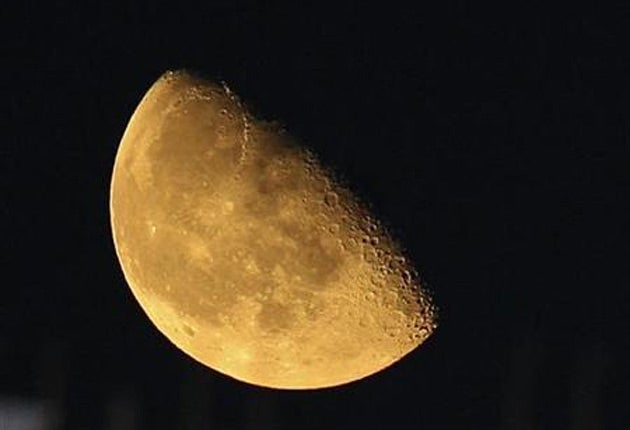Evidence of water found on moon

Your support helps us to tell the story
From reproductive rights to climate change to Big Tech, The Independent is on the ground when the story is developing. Whether it's investigating the financials of Elon Musk's pro-Trump PAC or producing our latest documentary, 'The A Word', which shines a light on the American women fighting for reproductive rights, we know how important it is to parse out the facts from the messaging.
At such a critical moment in US history, we need reporters on the ground. Your donation allows us to keep sending journalists to speak to both sides of the story.
The Independent is trusted by Americans across the entire political spectrum. And unlike many other quality news outlets, we choose not to lock Americans out of our reporting and analysis with paywalls. We believe quality journalism should be available to everyone, paid for by those who can afford it.
Your support makes all the difference.Scientists have found evidence of water, water everywhere on the surface of the Moon.
But there's not a drop to drink - for the water does not exist in liquid form but is bound up with minerals in lunar soil.
Nevertheless experts believe the discovery could have major implications for the future of moon exploration.
With suitable technology water could be extracted from moon dust and stored for use in lunar bases.
Hydrogen and oxygen, the two components of water, could also provide a valuable source of fuel and breathable air.
Data from three different orbiting satellites detected large quantities of water on the Moon, mostly at the poles but also at lower latitudes.
Scientists believe it got there as a result of bombardment by nuclear particles pouring out of the Sun.
Part of the Solar Wind consists of hydrogen atom nuclei. Striking the lunar surface, these are thought to have combined with oxygen in the rocks and soil to form water. About 45% of moon soil and rocks consists of oxygen, mostly bound up in silicates.
The new findings suggest that early assumptions about moon rocks brought home to Earth by the Apollo astronauts were wrong.
The samples, collected during the Apollo missions between 1969 and 1972, were found to bear traces of water. But experts at the time dismissed the finding, believing it to be due to contamination by air leaking into the sample containers.
Scientists were forced to think again after examining new data from an Indian spacecraft, Chandrayaan-1, which ceased operating last month.
A US instrument on the orbiter called the Moon Mineralogy Mapper, or "M3", measured light reflection patterns to analyse the composition of a thin layer of lunar top soil.
It detected wavelengths characteristic of water, and another type of hydrogen-oxygen chemical bonding called hydroxil.
Subsequently the findings were confirmed by similar recorded data from two missions by the American space agency Nasa.
The Cassini spacecraft made a flyby of the Moon in 1999 on its way to Saturn, and the Deep Impact probe now en route to a comet observed the Moon in June.
Both found further evidence of water over much of the lunar surface. How much might be present is unclear, but the quantities could be in the region of a quart of water per ton of soil.
The findings, published today in the journal Science, have excited experts around the world.
Dr Marc Norman, from the Australian National University in Canberra, who previously worked at Nasa's moon sample laboratory at the Johnson Space Centre in Houston, Texas, said: "This is a major discovery that will have a significant impact on international plans for exploration of the Moon. China and the US in particular will have significant interest in the distribution, size, and origin of this potential resource for human exploration.
"One caveat - it is important to realise that this is not liquid water like our oceans, nor ice like on the Mars polar caps. Rather this water on the Moon appears to be bound up with minerals such that it is stable in the airless and low-gravity environment of the Moon. So we won't be able to pump it like groundwater, but will have to collect fairly large volumes of lunar soil, then extract and store the water for use.
"This discovery will provide a huge boost to plans for devising robotic exploration and processing systems that work in the extremes of temperature, gravity, and dust found on the Moon, and to research into the origin of volatiles on the Moon."
Scientists describing the Chandrayaan-1 findings in the online edition of Science said harvesting water, oxygen and hydrogen from lunar soil was now "a serious option for long-term human activities".
Professor Larry Taylor, a member of the team from the University of Tennessee at Knoxville, US, explained how scientists made a mistake when they identified traces of water in the Apollo moon rocks.
Most of the boxes containing the rocks had leaked, leading experts to suspect contamination.
"To some extent, we were fooled," said Prof Taylor. "Since the boxes leaked, we just assumed the water we found was from contamination with terrestrial air.
"The isotopes (versions of atoms) of oxygen that exist on the Moon are the same as those that exist on Earth, so it was difficult if not impossible to tell the difference between water from the Moon and water from Earth.
"Since the early soil samples only had trace amounts of water, it was easy to make the mistake of attributing it to contamination."
Join our commenting forum
Join thought-provoking conversations, follow other Independent readers and see their replies
Comments